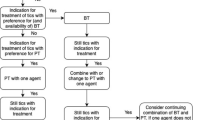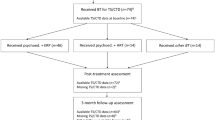Abstract
The formation of a new umbrella organisation called Tics and Tourette Across the Globe (TTAG) representing Tic and Tourette Syndrome (TS) patient associations around the world has led to a clearer voice for patients with Tourette Syndrome (TS). An opportunity has been created for this group to bridge research, clinical work and shared decision-making between researchers, clinicians and patients across Europe, with the result of improving the treatment and management of TS. A survey was sent out to capture the patients’ perspective on research and treatment, and 2269 participants responded. 71% of participants reported they would prefer research into how to treat TS and/or make symptoms better. The inclusion of patients’ perspectives on research and treatment in the updated European clinical guidelines for TS and other tic disorders highlights the new opportunities that have been created for the participation of patients in the discussion of TS research.





Similar content being viewed by others
Availability of data and material
Not applicable.
Change history
13 September 2021
A Correction to this paper has been published: https://doi.org/10.1007/s00787-021-01872-w
References
Oliver S (2006) Patient involvement in setting research agendas. Eur J Gastroenterol Hepatol 18:935–938
Hardavella G, Bjerg A, Saad N, Jacinto T, Powell P (2015) How to optimise patient and public involvement in your research: Doing science. Breathe (Sheff) 11(3):223–227. https://doi.org/10.1183/20734735.007615
Abma TA, Nierse CJ, Widdershoven GA (2009) Patients as partners in responsive research: Methodological notions for collaborations in mixed research teams. Qual Health Res 19:401–415
Ennis L, Wykes T (2013) Impact of patient involvement in mental health research: longitudinal study. British J Psych 203(5):381–386. https://doi.org/10.1192/bjp.bp.112.119818 (Epub 2013 Sep 12)
Abma TA, Broerse JE (2010) Patient participation as dialogue: Setting research agendas. Health Expect 13:160–173
Mazzoni D, van Leeuw B, Bednarova P, Marchiori F, Lerstrøm K (2015) Patients’ participation in research projects as partners. Lupus. https://doi.org/10.1177/0961203314561074
Biddle MSY et al (2021) (2021) Attitudes and approaches to patient and public involvement across Europe: a systematic review. Health Soc Care Community 29(1):18–27
Knowles SE, Allen D, Donnelly A et al (2021) More than a method: trusting relationships, productive tensions, and two-way learning as mechanisms of authentic co-production. Res Involv Engagem 7:34. https://doi.org/10.1186/s40900-021-00262-5
Abma TA, Pittens CA, Visse M, Elberse JE, Broerse JE (2015) Patient involvement in research programming and implementation. Health Expect 18:2449–2464. https://doi.org/10.1111/hex.12213
Straus S, Richardson WS, Haynes RB (2019) Evidence-based Medicine: how to practice and teach EBM, Fifth ed., Elsevier publishers
Anderson S (2018) European Tourette Syndrome research survey 2017–2018 https://doi.org/10.7490/f1000research.1115783.1
De Wit MP, Berlo SE, Aanerud GJ et al (2011) European League Against Rheumatism recommendations for the inclusion of patient representatives in scientific projects. Ann Rheum Dis 70:722–726
Schipper K, Abma TA, van Zadelhoff E et al (2010) What does it mean to be a patient research partner? An ethnodrama. Qual Inq 16:501–510
Wicks P, Richards T, Denegri S, Godlee F (2018) Patients’ roles and rights in research. BMJ. https://doi.org/10.1136/bmj.k3193
Pickett J, Murray M (2018) Editorial: Patient and public involvement in dementia research: Setting new standards. Dementia 17(8):939–943. https://doi.org/10.1177/1471301218789290
Boivin A et al (2018) Evaluating Patient and Public Involvement in Research. BMJ. https://doi.org/10.1136/bmj.k5147
White MA, Verhoef MJ (2005) Toward a patient-centered approach: incorporating principles of participatory action research into clinical studies. Integr Cancer Ther 4(1):21–24
Acknowledgements
Many thanks to all the patient associations around the world who helped with the survey and who came together to form the association Tics and Tourette Across the Globe (TTAG) representing Tic and Tourette Syndrome (TS) and the authors of the European Guidelines for all their help in putting this article together and also circulating the survey during the data collection. Many thanks also to the thousands of patients with TS and their families across Europe and the world who completed the survey.
Funding
No funding was received for the work on this manuscript.
Author information
Authors and Affiliations
Consortia
Corresponding author
Ethics declarations
Conflict of interest
The authors declare that they have no conflict of interest.
Code availability
Not applicable.
Additional information
The original online version of this article was revised due to addition of article note.
This article is part of the focused issue “Update of the European clinical guidelines for Tourette Syndrome and other tic disorders”.
Supplementary Information
Below is the link to the electronic supplementary material.
Rights and permissions
About this article
Cite this article
Anderson, S.M., on behalf of Tics and Tourette Around the Globe (TTAG) representing Tic and Tourette Syndrome (TS) patient associations around the world. European clinical guidelines for Tourette Syndrome and other tic disorders: patients’ perspectives on research and treatment. Eur Child Adolesc Psychiatry 31, 463–469 (2022). https://doi.org/10.1007/s00787-021-01854-y
Received:
Accepted:
Published:
Issue Date:
DOI: https://doi.org/10.1007/s00787-021-01854-y




